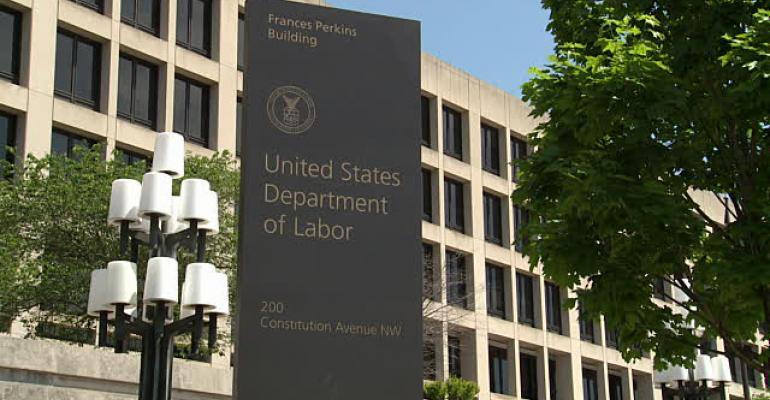Pershing provides clearing services for some 850 broker/dealers, all of which are grappling with the Department of Labor’s fiduciary rule, which went into effect June 9. At Pershing’s annual INSITE conference in San Diego last week, WealthManagement.com chatted with Robert Cirrotti, managing director of investment and retirement solutions at the firm, about how the DOL rule is playing out in the real world.
WealthManagement.com: How are firms navigating the DOL rule now that it’s in effect?
 Robert Cirrotti: On the one hand, I think there are still pockets of the industry that suspended either their implementation or their belief that this thing was actually going to take effect. I think that really puts them behind the eight ball.
Robert Cirrotti: On the one hand, I think there are still pockets of the industry that suspended either their implementation or their belief that this thing was actually going to take effect. I think that really puts them behind the eight ball.
On the flip side of that, there are plenty of other firms that are well prepared. I think the difficult part, with there still being an air of uncertainty, and with the pace of change, is that many of the decisions they made early on had to be revisited and readdressed in a short period of time, as the transition period started to get shaped differently as a result of the delay.
WM: The SEC is seeking comments on advice standards. Where do you think the SEC is going to go with this?
RC: I think, ultimately, the SEC will take action. I think it's going to take some time to do. I think that's probably one of the challenges with trying to get to greater coordination between the two agencies—the Department of Labor has an approach. They may modify that approach, but because of where we are in that cycle, it's likely to move along at a faster clip than the SEC's ability to take out a blank piece of paper and figure out how they're going to approach things. So while there may very well be cooperation and coordination, I think that it's going to be more of a stepped process than a singular, coordinated process across the two agencies. And, again, that kind of brings us back to where we were before in terms of the concern that we'll have multiple layers as compared with a holistic view of the standard of care.
WM: What are some of the big problems firms have with the DOL rule?
RC: I go back to when the rule was first finalized, when they proposed the final rule, and we did a webcast and one of the speakers said, "It's all about the BIC." And when you boil it all down, I think it's still all about the BIC. It's the contract, and the liability associated with class-action litigation, that is really what gives the industry fits.
So what we are likely to see in the department's request for information, which is currently with the Office of Management and Budget, are alternative approaches to the BIC exemption. I think that's where they're going to be seeking input from the industry, to see if we can get to a common consensus, if you will, on how to address and take some of the conflicts out of the system, while at the same time not needing to be as draconian as the BIC exemption can be.
WM: What do you think they would change about the BIC?
RC: They may not try to modify the BIC so much as try to create an alternative path that doesn't have the same onerous requirements. They certainly have a lot of interest in the concept of clean shares. While they may defer to the SEC on what the definition of a clean share is, they've expressed a lot of interest in trying to figure out how they can harness the concept, and potentially create a new path for the industry for dealing with the revenues and potential conflicts associated with a commission-based mutual fund business.
But another area that nobody's really talking about quite actively yet are the transaction-disclosure requirements that take effect in January.
WM: What are some of the big issues there?
RC: The biggest point that we made to them is that there are a lot of disclosure and regulatory regimes that exist in the industry. Much of the disclosure that's provided falls into two categories. It's not specific to a transaction, and it happens at the time of opening an account or something like that. And then there's disclosure that is transaction-specific. Think about a confirmation, as an example, and those things happen after the transaction occurs.
Anytime you put something about that transaction in front of the actual execution of that trade or that transaction, it puts a barrier to getting to the market; and, as we know, markets are fluid. While we appreciate that perspective, putting a disclosure that's transaction-specific before the transaction actually occurs is very complicated. Oftentimes you don't know all of the details about that transaction before it occurs. It's going to depend on the price. It's going to depend upon the volume. It's going to depend on any number of factors. And there are nuances to that across different types of securities.
WM: Do you know what the DOL rule is costing firms?
RC: We're impacted very differently in that we are really a solution to help support our clients' compliance efforts. We've publicly said, "We will spend an excess of $20 million just creating the support that our clients need to comply with the rule."
But there are many activities that firms still need to take on their end that involve significant investments, such as their compensation structures, investment product shelf, recruiting policies and ongoing supervision.
We've seen clients make some very difficult decisions about operations in order to improve supervision, things like no longer allowing their advisors to process business directives. Mutual fund companies taking active steps to move those positions to a single-broker platform, where they have a better view and better controls around the advice that's being provided to those investors.
You see very significant change that's occurring, and there's more to come because that's all with a watered-down transition period as well as a nonenforcement posture by the department.
WM: What about the new mutual fund share classes, clean shares, T shares, etc.? Are those catching on?
RC: There has been only a handful of fund companies that actually launched T shares as of the June 9 applicability date. Whereas if you asked that question 60 days ago, we had a list of probably 20 fund families who were all indicating they were going to be launching T shares for June 9. And I think that's been a little bit of this kind of circular dynamic between the asset managers trying to understand what the distribution side of the industry wants and needs, and the distribution side sort of asking the asset managers what they're going to have.
Second of all, there's a lot of confusion about clean shares and what the SEC said or didn't say in their response to Capital Group around clean shares.
So, what have we seen in the industry? T shares, broadly speaking, nobody has adopted them. While they are very responsive to the DOL rule in a lot of ways, there's a perspective that would say they weren't the best solution for investors.
If we get to the December time frame and the DOL has not pushed out the January compliance date or made significant changes to the rule, I think T shares will come roaring back because it's a more quick-to-market solution that firms are going to be looking for. If the rule gets pushed out, or there's some other kind of change that the department makes, I think it's much more likely that firms will put T shares on the shelf more permanently.
WM: How is the rule impacting registered investment advisors?
RC: I think they have to think differently than they have before about how they position themselves in the marketplace. They haven't cornered the market on "I'm a fiduciary." So I think that will cause firms to think more deeply about how they position themselves, what's the value that they bring, and how they operate firms. So will planning services become more central to how firms approach providing advice to investors? I think that is a change that we'll see over time.
This is also going to, perhaps, accelerate what I think is how firms will structure the next generation of advisors that they bring in. I think that's going to lead to much more salary-based types of structures. I think it's changing recruiting and the way that works. It changes the nature of the advisor as an entrepreneur who owns their own business and can sell it. On the one hand, the industry will find ways to de-risk the proposition of getting into the business. But, at the same time, that might put some limits on the upside for having your own practice, having your own business, being an entrepreneur, etc.





